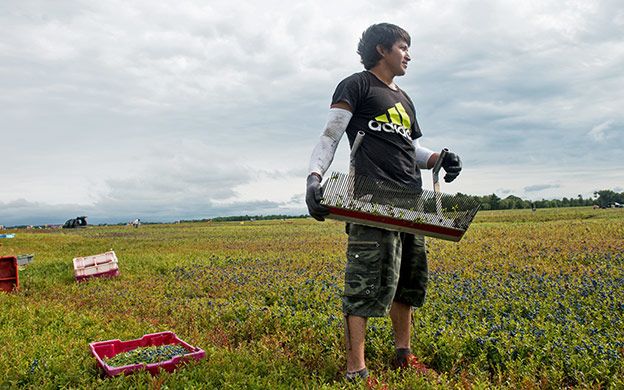Blueberry growers squeezed by price drop, bad weather
 Photo / Ted Axelrod, axelrodphotography.com
Maine's wild blueberry harvests of up to 100 million pounds a year represent a $250 million industry, according to the Wild Blueberry Commission of Maine. This year's harvest, however, has been beset by price drops, poor weather, diseases, foreign competition and reduced crop size, according to The Associated Press.
Photo / Ted Axelrod, axelrodphotography.com
Maine's wild blueberry harvests of up to 100 million pounds a year represent a $250 million industry, according to the Wild Blueberry Commission of Maine. This year's harvest, however, has been beset by price drops, poor weather, diseases, foreign competition and reduced crop size, according to The Associated Press.
Maine’s blueberry industry continues to deal with price drops, unaccommodating weather, diseases, foreign competition and reduced crop size.
According to an Associated Press report published in the Bangor Daily News, this year’s harvest at Beech Hill Blueberry Farm in Rockport was off by about 50%.
“For years, the health message and the taste message of wild blueberries has been successful,” Nancy McBrady, executive director of the Wild Blueberry Commission of Maine, told the AP. “But it’s frustrating when we find ourselves in periods of oversupply and competition.”
The harvest of Maine's wild blueberry crop began in July. At that time, the Ellsworth American reported that in 2017 poor growing conditions and a glut from the previous season resulted in a harvest of 67.8 million pounds 33%, which represented a 33% drop in production from 2016 and a 37% drop in the harvest's value, to $17.6 million.
Maine is the world's top producer of wild blueberries, at up to 100 million pounds a year, which brings $250 million into the state, according to the Wild Blueberry Commission of Maine.
According to a February 2018 post by the Wild Blueberry Commission of Maine, in Orono, the industry and the extension have established a suite of research priorities. They encompass cropping system management like understanding the influence that increasing climate variability has on wild blueberry plant development stages and integrated crop management systems in order to improve crop yield and profitability and developing economic tools to improve crop profitability; plant nutrition; pest management systems; production and processing food safety, like investigating opportunities to maintain and improve post-harvest food safety and quality of wild blueberries; and education, like providing best management and site specific practices for wild blueberry growers.
According to the University of Maine Cooperative Extension’s July 2018 newsletter, the 2017 wild blueberry crop for Maine, as reported by the USDA National Agricultural Statistics Service on June 25, 2018, totaled 67.8 million pounds, which was considerably smaller than 101.8 million pounds harvested in 2016.
“Maine has had over 100 million pounds each year from 2014 to 2016 and has not had such a low crop since 2005,” the newsletter says. “The acres harvested in 2017 also decreased, from 23,100 in 2016 to 17,000 in 2017. The Maine slice of the blueberry pie decreased from 9% to 7% of the total North American Crop.
The wild blueberry crop in Canada was also much smaller than the previous five years.
And the cultivated blueberry industry also had smaller harvests. Total cultivated production in North America reported by the North American Blueberry Council for 2017 was 431.5 million pounds fresh and 259.4 million pounds processed for a total crop of 690.9 million pounds.
“This crop was considerably smaller than 766 million pounds in 2016 and only 37% of it was processed whereas in 2016 over 50% of the cultivated crop was processed,” the newsletter said.








Comments